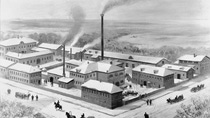Who we are
Evolving into a Global Player – Major Characteristics
Joint ventures, Styropor, Butirki - these and other terms show steps in development and attributes which are characteristic of the BASF on its path from a Palatine dye factory to the world's leading chemical company.
A few years after its foundation, BASF starts to establish a distribution channel with global scope. For the first time, it captures the benefits of an international sales network and is able to build up a direct contact to the customers. But the expansion of BASF initially remains limited to the field of exports. The company's concept is fitted to the head office in Ludwigshafen as a center of research, production and organization. Only in exceptional cases and only on a small scale, production facilities are set up abroad, for example, in Butirki, Russia, in 1877. They owe their existance to customs or patent providions.
With the start of production of Styropor in the 1950s, new production facilities for this classic insulating material are set up all over the world because shipping the very voluminous foam over longer distances would be too expensive. Since the 1960s, the focus of BASF's strategy becomes more and more international. By means of new capital expenditures, joint ventures, the construction of its own facilities and establishing Verbund sites, BASF manages to extend its worldwide presence. Research facilities on all continents follow later. To this day, BASF has evolved into a transnational company which is trading, producing and researching all over the world.



